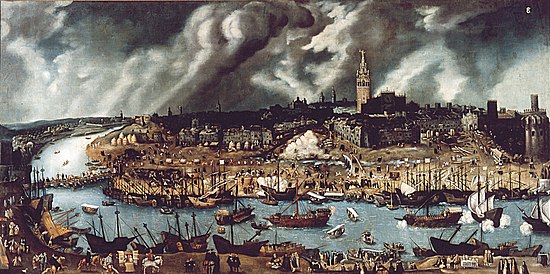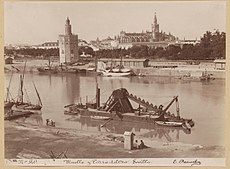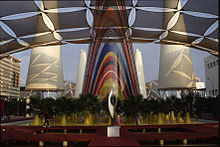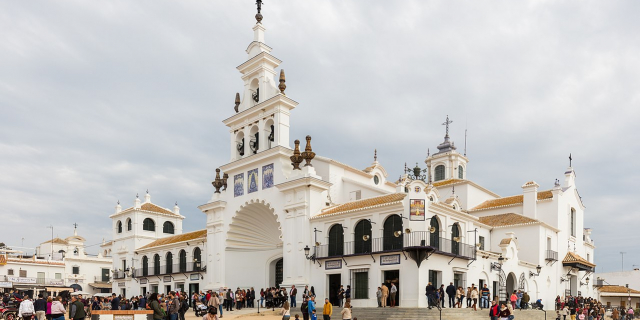Seville ( sə-VIL; Spanish: Sevilla, pronounced [seˈβiʎa] ) is the capital and largest city of the Spanish autonomous community of Andalusia and the province of Seville. It is situated on the lower reaches of the River Guadalquivir, in the southwest of the Iberian Peninsula.
Seville has a municipal population of about 701,000 as of 2022, and a metropolitan population of about 1.5 million, making it the largest city in Andalusia, the fourth-largest city in Spain and the 26th most populous municipality in the European Union. Its old town, with an area of 4 square kilometres (2 sq mi), contains a UNESCO World Heritage Site comprising three buildings: the Alcázar palace complex, the Cathedral and the General Arc...Read more
Seville ( sə-VIL; Spanish: Sevilla, pronounced [seˈβiʎa] ) is the capital and largest city of the Spanish autonomous community of Andalusia and the province of Seville. It is situated on the lower reaches of the River Guadalquivir, in the southwest of the Iberian Peninsula.
Seville has a municipal population of about 701,000 as of 2022, and a metropolitan population of about 1.5 million, making it the largest city in Andalusia, the fourth-largest city in Spain and the 26th most populous municipality in the European Union. Its old town, with an area of 4 square kilometres (2 sq mi), contains a UNESCO World Heritage Site comprising three buildings: the Alcázar palace complex, the Cathedral and the General Archive of the Indies. The Seville harbour, located about 80 kilometres (50 miles) from the Atlantic Ocean, is the only river port in Spain. The capital of Andalusia features hot temperatures in the summer, with daily maximums routinely above 35 °C (95 °F) in July and August.
Seville was founded as the Roman city of Hispalis. Known as Ishbiliyah after the Islamic conquest in 711, Seville became the centre of the independent Taifa of Seville following the collapse of the Caliphate of Córdoba in the early 11th century; later it was ruled by Almoravids and Almohads until being incorporated to the Crown of Castile in 1248. Owing to its role as gateway of the Spanish Empire's trans-atlantic trade, managed from the Casa de Contratación, Seville became one of the largest cities in Western Europe in the 16th century. Coinciding with the Baroque period, the 17th century in Seville represented the most brilliant flowering of the city's culture. Upon diminishing draught conditions in the Guadalquivir, the American trade gradually moved away from the city of Seville, initially in favor of downstream dependent berths and eventually in favor of the Bay of Cádiz, where the head of the fleets of the Indies (1680) and the Casa de la Contratación (1717) were eventually transferred to.
The 20th century in Seville saw the tribulations of the Spanish Civil War, decisive cultural milestones such as the Ibero-American Exposition of 1929 and Expo '92, and the city's election as the capital of the Autonomous Community of Andalusia.
Seville is approximately 2,200 years old. The passage of the various civilizations instrumental in its growth has left the city with a distinct personality, and a large and well-preserved historical centre.
Early periods Treasure of El Carambolo, belonging to the ancient Tartessian sanctuary located 3 kilometers west of Seville.
Treasure of El Carambolo, belonging to the ancient Tartessian sanctuary located 3 kilometers west of Seville. Section of Caños de Carmona
Section of Caños de CarmonaThe mythological founder of the city is Hercules (Heracles), commonly identified with the Phoenician god Melqart, who the myth says sailed through the Strait of Gibraltar to the Atlantic, and founded trading posts at the current sites of Cádiz and of Seville.[1] The original core of the city, in the neighbourhood of the present-day street, Cuesta del Rosario, dates to the 8th century BC,[2] when Seville was on an island in the Guadalquivir.[3] Archaeological excavations in 1999 found anthropic remains under the north wall of the Real Alcázar dating to the 8th–7th century BC.[4] The town was called Hisbaal by the Phoenicians and by the Tartessians, the indigenous pre-Roman Iberian people of Tartessos, who controlled the Guadalquivir Valley at the time.
The city was known from Roman times as Hispal and later as Hispalis. Hispalis developed into one of the great market and industrial centres of Hispania, while the nearby Roman city of Italica (present-day Santiponce, birthplace of the Roman emperors Trajan and Hadrian)[5] remained a typically Roman residential city. Large-scale Roman archaeological remains can be seen there and at the nearby town of Carmona as well.
Existing Roman features in Seville itself include the remains exposed in situ in the underground Antiquarium of the Metropol Parasol building, the remnants of an aqueduct, three pillars of a temple in Mármoles Street, the columns of La Alameda de Hércules and the remains in the Patio de Banderas square near the Seville Cathedral. The walls surrounding the city were originally built during the rule of Julius Caesar, but their current course and design were the result of Moorish reconstructions.[6]
Following Roman rule, there were successive conquests of the Roman province of Hispania Baetica by the Germanic Vandals, Suebi and Visigoths during the 5th and 6th centuries.
Middle AgesIn the wake of the Islamic conquest of the Iberian Peninsula, Seville (Spalis) was seemingly taken by Musa ibn Nusayr in the late summer of 712, while he was on his way to Mérida.[7] Yet it had to be retaken in July 713 by troops led by his son Abd al-Aziz ibn Musa, as the Visigothic population who had fled to Beja had returned to Seville once Musa left for Mérida.[7] The seat of the Wali of Al-Andalus (administrative division of the Umayyad Caliphate) was thus established in the city until 716,[7] when the capital of Al-Andalus was relocated to Córdoba.[8]
Seville (Ishbīliya) was sacked by Vikings in the mid-9th century. After Vikings arrived by 25 September 844, Seville fell to invaders on 1 October, and they stood for 40 days before they fled from the city.[9] During Umayyad rule, under an Andalusi-Arab framework, the bulk of the population were Muladi converts, to which Christian and Jewish minorities added up.[10] Up until the arrival of the Almohads in the 12th century, the city remained as the see of a Metropolitan Archbishop,[11] the leading Christian religious figure in al-Andalus. However, the transfer of the relics of Saint Isidore to León circa 1063, in the taifa period, already hinted at a possible worsening of the situation of the local Christian minority.[12]
A powerful taifa kingdom with capital in Seville emerged after 1023,[13] in the wake of the fitna of al-Andalus. Ruled by the Abbadid dynasty, the taifa grew by aggregation of smaller neighbouring taifas.[13] During the taifa period, Seville became an important scholarly and literary centre.[13] After several months of siege, Seville was conquered by the Almoravids in 1091.[14]
The city fell to the Almohads on 17 January 1147 (12 Shaʽban 541).[15][16] After an informal Almohad settlement in Seville during the early stages of the Almohad presence in the Iberian Peninsula and then a brief relocation of the capital of al-Andalus to Córdoba in 1162 (which had dire consequences for Seville, reportedly depopulated and under starvation),[17] Seville became the definitive seat of the Andalusi part of the Almohad Empire in 1163,[18][19] a twin capital alongside Marrakesh. Almohads carried out a large urban renewal.[20] By the end of the 12th century, the walled enclosure perhaps contained 80,000 inhabitants.[21]
 The Patio de las Doncellas in the Alcázar of Seville
The Patio de las Doncellas in the Alcázar of SevilleIn the wider context of the Castilian–Leonese conquest of the Guadalquivir Valley that ensued in the 13th century, Ferdinand III laid siege on Seville in 1247. A naval blockade came to prevent relief of the city.[22] The city surrendered on 23 November 1248,[23] after fifteen months of siege. The conditions of capitulation contemplated the eviction of the population, with contemporary sources seemingly confirming that a mass movement of people out of Seville indeed took place.[24]
The city's development continued after the Castilian conquest in 1248. Public buildings were constructed including churches—many of which were built in the Mudéjar and Gothic styles—such as the Seville Cathedral, built during the 15th century with Gothic architecture.[25] Other Moorish buildings were converted into Catholic edifices, as was customary of the Catholic Church during the Reconquista. The Moors' Palace became the Castilian royal residence, and during Pedro I's rule it was replaced by the Alcázar (the upper levels are still used by the Spanish royal family as the official Seville residence).
After the 1391 pogrom, believed to having been instigated by the Archdeacon Ferrant Martínez, all the synagogues in Seville were converted to churches (renamed Santa María la Blanca, San Bartolomé, Santa Cruz, and Convento Madre de Dios). The Jewish quarter's land and shops (which were located in modern-day Santa Cruz neighbourhood) were appropriated by the church. Many Jews were killed during the pogrom, although most were forced to convert.
The first tribunal of the Spanish Inquisition was instituted in Seville in 1478. Its primary charge was to ensure that all nominal Christians were really behaving like Christians, and not practicing what Judaism they could in secret. At first, the activity of the Inquisition was limited to the dioceses of Seville and Córdoba, where the Dominican friar, Alonso de Ojeda, had detected converso activity.[26] The first Auto de Fé took place in Seville on 6 February 1481, when six people were burned alive. Alonso de Ojeda himself gave the sermon. The Inquisition then grew rapidly. The Plaza de San Francisco was the site of the 'autos de fé'. By 1492, tribunals existed in eight Castilian cities: Ávila, Córdoba, Jaén, Medina del Campo, Segovia, Sigüenza, Toledo, and Valladolid;[27] and by the Alhambra Decree all Jews were forced to convert to Catholicism or be exiled (expelled) from Spain.[28]
Early modern periodFollowing the Columbian exploration of the New World, Seville was chosen as headquarters of the Casa de Contratación in 1503, which was the decisive development for Seville becoming the port and gateway to the Indies.[29] Unlike other harbours, reaching the port of Seville required sailing about 80 kilometres (50 mi) up the River Guadalquivir. The choice of Seville was made in spite of the difficulties for navigation in the Guadalquivir stemming from the increasing tonnage of ships as a result of the relentless drive to make maritime transport cheaper during the late Middle Ages.[30] Nevertheless, technical suitability issues notwithstanding, the choice was still reasonable in the sense that Seville had become the largest demographic, economic and financial centre of Christian Andalusia in the late Middle Ages.[31] In addition, factors favouring the choice of Seville include the Andalusian coastline being largely under the seigneurial control of the House of Medina Sidonia, Seville enjoying an important hinterland and administrative expertise, and its inland location also providing conditions for military security and enforcement of tax control.[32]
A 'golden age of development' commenced in Seville, due to its being the only port awarded the royal monopoly for trade with the growing Spanish colonies in the Americas and the influx of riches from them.
Since only sailing ships leaving from and returning to the inland port of Seville could engage in trade with the Spanish Americas, merchants from Europe and other trade centres needed to go to Seville to acquire New World trade goods. The city's population grew to more than a hundred thousand people.[33]
 Seville in the late 16th century
Seville in the late 16th century Anonymous painting illustrating the effects of the 1649 plague
Anonymous painting illustrating the effects of the 1649 plagueIn the late 16th century the monopoly was broken, with the port of Cádiz also authorised as a port of trade. Throughout the 17th century, colonial trade declined. Spain's American Colonies improved their production of basic goods, reducing their need to import. Compounded with these tribulations was the silting of the Guadalquivir river in the 1620s, which made Seville's harbors harder to use, and ceased upriver shipping.[34][35] The Great Plague of Seville in 1649, exacerbated by excessive flooding of the Guadalquivir, reduced the population by almost half, and it would not recover until the early 19th century.[36][37] By the 18th century, Seville's international importance was in decline. After the silting up of the harbour by the River Guadalquivir, upriver shipping ceased and the city went into relative economic decline.[citation needed]
The writer Miguel de Cervantes lived primarily in Seville between 1596 and 1600. Because of financial problems, Cervantes worked as a purveyor for the Spanish Armada, and later as a tax collector. In 1597, discrepancies in his accounts of the three years previous landed him in the Royal Prison of Seville for a short time. His short story Rinconete y Cortadillo, since the 19th century one of his most-read pieces, includes much description of Sevillian society; it features two young vagabonds who come to Seville, attracted by the riches and disorder that the 16th-century commerce with the Americas had brought to the city.
 1747 parade organised by the workers of the Royal Tobacco Factory
1747 parade organised by the workers of the Royal Tobacco FactoryDuring the 18th century Charles III of Spain promoted Seville's industries. Construction of the Real Fábrica de Tabacos (Royal Tobacco Factory) began in 1728. It was the second-largest building in Spain, after the royal residence El Escorial. Since the 1950s it has been the seat of the rectorate (administration) of the University of Seville, as well as its Schools of Law, Philology (language/letters), Geography, and History.[38]
More operas have been set in Seville than in any other city of Europe. In 2012, a study of experts concluded the total number of operas set in Seville is 153. Among the composers who fell in love with the city are Beethoven (Fidelio), Mozart (The Marriage of Figaro and Don Giovanni), Rossini (The Barber of Seville), Donizetti (La favorite), and Bizet (Carmen).[39]
The first newspaper in Spain outside of Madrid was Seville's Hebdomario útil de Seville, which began publication in 1758.
Late modern history The Torre del Oro and the harbor in the second half of the 19th century
The Torre del Oro and the harbor in the second half of the 19th centuryBetween 1825 and 1833, Melchor Cano acted as chief architect in Seville; most of the urban planning policy and architectural modifications of the city were made by him and his collaborator Jose Manuel Arjona y Cuba.[40]
Industrial architecture surviving today from the first half of the 19th century includes the ceramics factory installed in the Carthusian monastery at La Cartuja in 1841 by the Pickman family, and now home to the El Centro Andaluz de Arte Contemporáneo (CAAC),[41] which manages the collections of the Museo de Arte Contemporáneo de Sevilla.[42] It also houses the rectory of the UNIA.[43]
In the years that Queen Isabel II ruled directly, about 1843–1868, the Sevillian bourgeoisie invested in a construction boom unmatched in the city's history. The Isabel II bridge, better known as the Triana bridge, dates from this period; street lighting was expanded in the municipality and most of the streets were paved during this time as well.[44]
By the second half of the 19th century, Seville had begun an expansion supported by railway construction and the demolition of part of its ancient walls, allowing the urban space of the city to grow eastward and southward. The Sevillana de Electricidad Company was created in 1894 to provide electric power throughout the municipality,[45] and in 1901 the Plaza de Armas railway station was inaugurated.
 Poster for the Ibero-American Exposition of 1929
Poster for the Ibero-American Exposition of 1929The Museum of Fine Arts (Museo de Bellas Artes de Sevilla) opened in 1904.
In 1929 the city hosted the Ibero-American Exposition, which accelerated the southern expansion of the city and created new public spaces such as the Parque de María Luisa (Maria Luisa Park) and the adjoining Plaza de España. Not long before the opening, the Spanish government began a modernisation of the city in order to prepare for the expected crowds by erecting new hotels and widening the mediaeval streets to allow for the movement of automobiles.[46]
 General Varela rallying military and civilians in Seville (September 1936)
General Varela rallying military and civilians in Seville (September 1936)Seville fell very quickly at the beginning of the Spanish Civil War in 1936. General Queipo de Llano carried out a coup within the city, quickly capturing the city centre.[47] Radio Seville opposed the uprising and called for the peasants to come to the city for arms, while workers' groups established barricades.[47] Queipo then moved to capture Radio Seville, which he used to broadcast propaganda on behalf of the Francoist forces.[47] After the initial takeover of the city, resistance continued among residents of the working-class neighbourhoods for some time, until a series of fierce reprisals took place.[48]
Under Francisco Franco's rule Spain was officially neutral in World War II (although it did collaborate with the Axis powers),[49][50][51] and like the rest of the country, Seville remained largely economically and culturally isolated from the outside world. In 1953 the shipyard of Seville was opened, eventually employing more than 2,000 workers in the 1970s. Before the existence of wetlands regulation in the Guadalquivir basin, Seville suffered regular heavy flooding; perhaps worst of all were the floods that occurred in November 1961 when the River Tamarguillo, a tributary of the Guadalquivir, overflowed as a result of a prodigious downpour of rain, and Seville was consequently declared a disaster zone.[52]
Trade unionism in Seville began during the 1960s with the underground organisational activities of the Workers' Commissions or Comisiones Obreras (CCOO), in factories such as Hytasa, the Astilleros shipyards, Hispano Aviación, etc. Several of the movement's leaders were imprisoned in November 1973.[citation needed]
Recent developmentsOn 3 April 1979 Spain held its first democratic municipal elections after the end of Franco's dictatorship; councillors representing four different political parties were elected in Seville. On 5 November 1982, Pope John Paul II arrived in Seville to officiate at a Mass before more than half a million people at the fairgrounds. He visited the city again on 13 June 1993, for the International Eucharistic Congress.
 European Union pavilion of the 1992 Universal Exposition as it was at the time.
European Union pavilion of the 1992 Universal Exposition as it was at the time.In 1992, coinciding with the fifth centenary of the Discovery of the Americas, the Universal Exposition was held for six months in Seville, on the occasion of which the local communications network and urban infrastructure was greatly improved under a 1987 PGOU plan launched by Mayor Manuel del Valle:[53] the SE-30 ring road around the city was completed and new highways were constructed; the new Seville-Santa Justa railway station had opened in 1991, while the Spanish High-Speed Rail system, the Alta Velocidad Española (AVE), began to operate between Madrid-Seville. The Seville Airport was expanded with a new terminal building designed by the architect Rafael Moneo, and various other improvements were made. The Alamillo Bridge and the Centenario Bridge, both crossing over the Guadalquivir, also were built for the occasion. Some of the installations remaining at the site after the exposition were converted into the Scientific and Technological Park Cartuja 93.
In 2004 the Metropol Parasol project, commonly known as Las Setas ('The Mushrooms'), due to the appearance of the structure, was launched to revitalise the Plaza de la Encarnación, for years used as a car park and seen as a dead spot between more popular tourist destinations in the city. The Metropol Parasol was completed in March 2011,[54] costing just over €102 million in total, more than twice as much as originally planned.[55] Constructed from crossed wooden beams, Las Setas is said to be the largest timber-framed structure in the world.[56]









































Add new comment